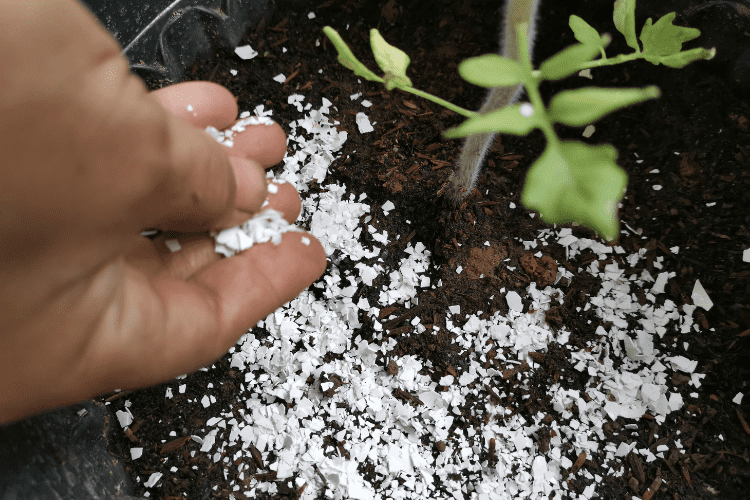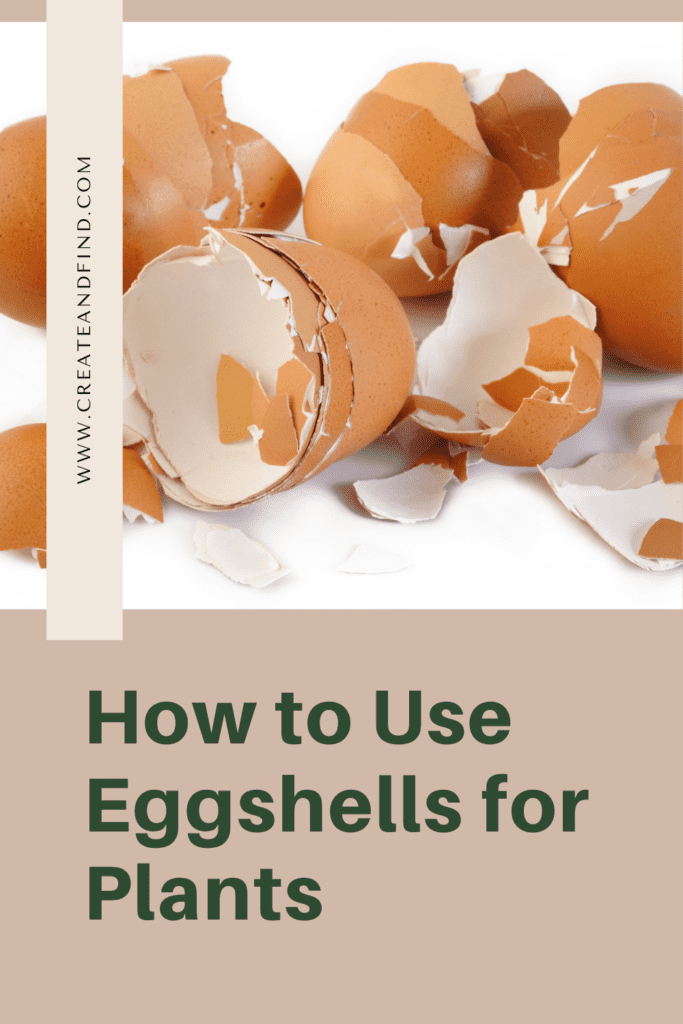Feeding eggshells to your plants can help provide the proper nutrition without using toxic store chemicals. In addition, spent eggshells are a fantastic organic source of fertilizer. And they’re high in several crucial nutrients your acidic plants need, including calcium.
Keep reading to find out everything you’d need to know about using eggshells for your plants, including the process, recipes, and benefits.
Using Eggshells for Plants
Eggshells are thin pieces of sodium bicarbonate that contain high doses of calcium that can boost healthy plant growth.
But shells also have other beneficial nutrients that your plants will love, including copper, zinc, potassium, magnesium, sodium, phosphorus, iron, and manganese.
What Benefits Do Eggshells have for Plants?
Eggshells can provide several benefits for plants. First, these fragile shells contain high traces of crucial secondary nutrients when ground up and tilled into the soil.
Plants need more than potassium, phosphorus, and nitrogen to stay healthy. Eggshells can also care for plants’ calcium, sulfur, and magnesium needs.
When plants go without calcium, they can become weak and vulnerable to diseases. Signs that your plants aren’t getting the required calcium include:
- Curling leaves
- Root disease
- Leaf edge necrosis
- Deformed or stunted growth
- Burned leaf tips
- Blossom end rot
Eggshells can also offer protection to your plants from insect infestations. As the eggshells decay – which takes several months – the calcium carbonate starts to break down.
If you’ve ever encountered the smell of rotten eggs, you understand why the putrid scent is unpleasant to pests. You can also make a ring around your plants to prevent slugs on hostas, potatoes, and lettuce.
However, the scent can also attract rodents. So you’ll want to find a medium ground between prepping the eggshells to keep enough of the smell to rid pests. But without it being too strong that it encourages mice and other vermin.
Eggshells also work efficiently as garden mulch. Crushed shells can prevent weed growth in your garden. And as an extra benefit, it creates a visually pleasing aesthetic.
Which Plants like Eggshells?
Eggshells can be a valuable organic fertilizer to add to many plants in place of synthetic products. You can use shells on most of your veggie garden, including around:
- Eggplants
- Cauliflower
- Tomatoes
- Broccoli
- Peppers
- Swiss chard
- Amaranth
- Potatoes
- Spinach
- Squash
- Lettuce
You can also use eggshells for other calcium-loving plants to encourage healthy root growth. The extra calcium boost prevents root rot and adds different nutrients to look visually attractive.
How Do I Add Eggshells to Soil?
You’ll need to prepare the shells correctly if you plan to use eggshells for plants indoors or outside. If you don’t clean and dry the surfaces properly, you’ll have the stench of rotting eggs that will attract rodents and not provide much nutritional value to your plants.
After you use the eggs, rinse the shells out with cold water. Then set them aside to dry out in an open container, like the egg carton. You can continue saving empty, cleaned egg shells until the carton is full or until you’re ready to fertilize your eggs.
Crushing the eggshells in the carton can make room for new shells. You can pulverize the shells with a wooden spoon until you have tiny pieces and ground eggshell dust.
There are a few ways to add these eggshells to your soil, including broken pieces, ground-down dust, or tea.

- Broken eggshell bits
The small pieces can rest as a solid layer on the dirt. These hard white pieces can also add a contrasting look against the darkness of the brown soil. And they’ll work as a slow-release feed that breaks down slowly over several months.
But one study suggests that plants get more nutrients from eggshell dust but little to no benefit from the solid shell pieces that take months to decompose.
- Ground eggshell powder
Eggshells take several months to decompose when left in a chunky, solid state. So, it’s best to grind the eggshells into a fine powder. This powder will dissolve when you pour water onto the dirt.
You can use a food processor, blender, or coffee grinder to get a fine powder. Then you can sprinkle this powder onto the dirt and work it down into the soil to provide nutrients to the plant roots.
- Eggshell tea
Another option is to make eggshell tea. For this recipe, you’ll need 10 to 20 eggshells that you’ve rinsed out with warm water and dried. On average, you’ll want two to five eggshells per plant.
Boil these shells in one gallon of water and let them soak for one day. Crushing the shells before you boil them can release more calcium and create more surface area.
Once you strain the water, apply it to your plants. An alternative, more complex method is to use vinegar instead of water.
Remember that although you’re calling this tea, it’s watering your plants. So, don’t overapply the liquid. You can apply the tea to your indoor plants once a week or biweekly (every two weeks) to get optimal growth.
- Vinegar eggshell tea
You can also use clean, ground eggshells mixed with vinegar for a fun, scientific fertilization method. Vinegar contains acetic acid that chemically reacts with calcium carbonate. As these components combine, you get a foaming action as water-soluble calcium releases.
For this method, you’ll need one teaspoon of crushed, boiled eggshell powder with one tablespoon of white vinegar. Leave this solution to steep overnight.
You will need to dilute your mix with one gallon – 8 pints – of water before applying the solution to your plants for a good soaking.
Do Succulents like Eggshells?
Succulents can do well with an eggshell fertilizer, even though they do not require high calcium doses. You can apply a shell feed as tea, powder, or chunky pieces.
To make an eggshell tea for your succulents and cacti, add ten eggshells to one gallon of boiled water. You can increase it to twenty shells for a strong brew.
Some people like to heat the shells in the oven for about twenty minutes at 200℉ (93℃). Then transfer the shells to the boiled water and let them steep overnight. Strain the solution the next morning and use the water for your plants once weekly.
If you are adding pieces of raw eggshells to your pots, put them at the bottom of the pot over the drainage holes. You only need to add eggshell pieces one or two times yearly.
Are Eggshells Good for Indoor Plants?
Natural eggshell fertilizers can be beneficial for all plants grown indoors. But edible plants will get the most benefit since they crave extra calcium than regular houseplants.
You should especially use eggshells to feed tomato plants. This is because they are highly susceptible to getting blossom end rot. However, eggshells can also be good for lettuce, and carrots are grown indoors. Outside, you can use shells for cucumbers too.
Eggshells are also beneficial for ornamentals that prefer a higher alkaline soil pH and a calcium boost. You can use an eggshell feed on Clematis, Lilacs, Crocus, Bluebeard, Forsythia, Red Tip Photinia, Barberry, and Butterfly Bush.
Are There Plants that Don’t like Eggshells?
Because eggshells contain high calcium levels, you shouldn’t use them on or around plants that prefer acidic soil.
Adding eggshells to the soil around species such as ferns, roses, lilies, hydrangeas, blueberries, radishes, carrots, cabbage, hollies, rhododendrons, and azaleas can cause damage or death to your plants.
How Often Do I Add Eggshells to My Plants?
Your acidic-loving plants can benefit from a dose of eggshell feeder once a week for plants that love water and heavy amounts of calcium. Other plants may do best with feedings every other week.
Eggshells are an Excellent Organic Plant Fertilizer
You can use eggshells to fertilize nearly any indoor house plant and many outdoor plants that prefer alkaline pH soils. But you should not use eggshells to feed plants that like acidic pHs. It’s possible to provide plants with eggshells as powder, tea, or pieces, as often as once a week to once yearly.
So start saving those eggshells and help your plants thrive!




